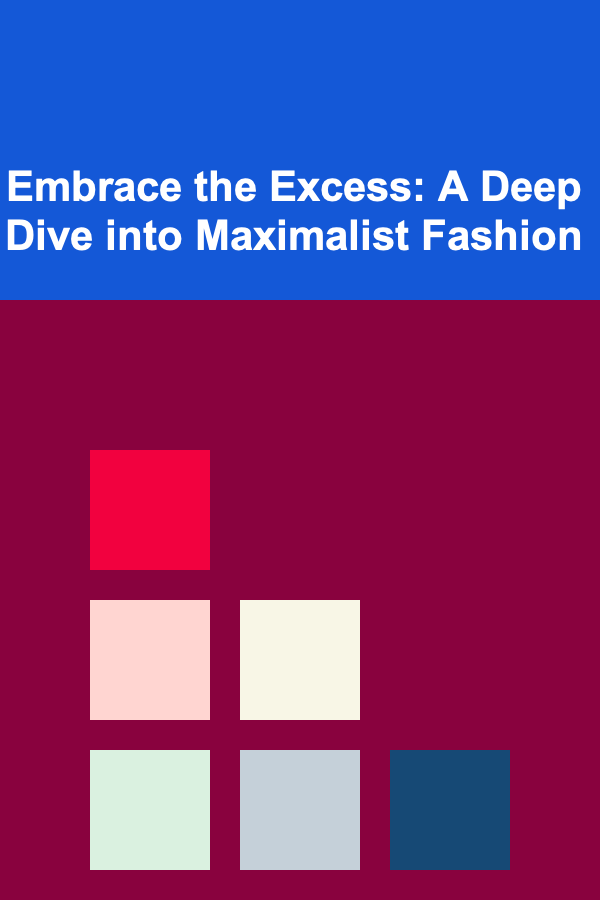
Embrace the Excess: A Deep Dive into Maximalist Fashion
ebook include PDF & Audio bundle (Micro Guide)
$12.99$7.99
Limited Time Offer! Order within the next:

In a world often dominated by minimalist aesthetics and the pursuit of understated elegance, maximalist fashion stands as a bold and unapologetic declaration of self-expression. It's a movement that celebrates abundance, embraces eclecticism, and encourages the wearer to pile on patterns, textures, and colors with joyful abandon. But navigating the world of maximalism can be daunting. It's more than just throwing everything together; it requires a discerning eye, a sense of balance, and a willingness to experiment. This article will explore the key elements of maximalist fashion and provide practical advice on how to incorporate its trends into your personal style, whether you're a seasoned fashion enthusiast or a curious beginner.
Understanding Maximalism: More Than Just "More"
At its core, maximalism is about intentional excess. It's a rejection of the "less is more" philosophy, opting instead for a celebration of individuality through a carefully curated clash of styles. It's not about mindless accumulation; it's about creating a harmonious visual symphony from seemingly disparate elements. While it might appear chaotic at first glance, true maximalist style is rooted in thought and purpose.
To truly understand maximalism, consider these key characteristics:
- Layering: Maximalism thrives on layering clothing, accessories, and even textures. Think a patterned blouse under a brightly colored blazer, topped with a statement necklace and a collection of rings.
- Pattern Mixing: Don't be afraid to combine stripes with florals, polka dots with paisley, or geometric prints with animal prints. The key is to find patterns that complement each other in terms of color or scale.
- Color Blocking and Clashing: Embrace bold and unexpected color combinations. Think electric blue with vibrant orange, or emerald green with hot pink. The goal is to create visual interest and a sense of energy.
- Texture Play: Mix smooth textures like silk with rough textures like tweed, or combine soft fabrics like velvet with structured fabrics like leather. The contrast in textures adds depth and dimension to your look.
- Accessorizing to the Max: Accessories are crucial in maximalist style. Pile on necklaces, bracelets, rings, earrings, scarves, hats, and statement belts. Don't be afraid to experiment with different styles and materials.
- Personal Expression: Above all, maximalism is about expressing your personality and passions through your clothing. Incorporate items that have personal meaning, reflect your interests, and tell a story.
Where Did Maximalism Come From? A Brief History
Maximalism in fashion isn't a completely new phenomenon. Its roots can be traced back to various historical periods and subcultures that celebrated ornamentation and extravagance. Consider these influences:
- Rococo Era: The 18th-century Rococo period, known for its ornate decoration, elaborate gowns, and powdered wigs, was a clear predecessor to modern maximalism.
- Victorian Era: The Victorian era, with its emphasis on embellishment, layers of fabric, and extravagant accessories, also contributed to the maximalist aesthetic.
- Bohemian Style: The bohemian movement, with its focus on individuality, free-spiritedness, and eclectic mix of cultures, laid the groundwork for maximalist principles.
- Punk and New Wave: These counter-cultural movements of the late 20th century challenged conventional fashion norms and embraced bold colors, unconventional materials, and a DIY aesthetic, influencing the current maximalist trend.
- The 1980s: The decade of excess, with its power dressing, neon colors, and bold accessories, was a high point for maximalist fashion.
Today's maximalist trend can be seen as a reaction against the minimalist movement that dominated the fashion world for several years. It's a celebration of individuality, creativity, and the joy of dressing up.
Incorporating Maximalist Trends: A Step-by-Step Guide
Feeling inspired but not sure where to start? Here's a practical guide to incorporating maximalist trends into your wardrobe without feeling overwhelmed:
1. Start Small and Experiment:
Don't feel pressured to overhaul your entire wardrobe overnight. Begin by incorporating one or two maximalist elements into your existing outfits. For example:
- Add a Statement Accessory: Try wearing a large, colorful necklace, a pair of bold earrings, or a stack of bangles with a simple outfit.
- Introduce a Pop of Color: Wear a brightly colored scarf, handbag, or pair of shoes with a neutral-toned outfit.
- Experiment with Pattern Mixing: Combine a striped top with a floral skirt, or a polka dot blouse with a pair of plaid pants. Start with subtle patterns in similar color families.
The key is to experiment and see what works for you. Don't be afraid to try new things and push your boundaries.
2. Focus on a Color Palette:
While maximalism embraces bold colors, it's important to maintain some level of cohesion. Choose a color palette that you love and that complements your skin tone. This will help you create a more harmonious and visually appealing look. Some popular maximalist color palettes include:
- Jewel Tones: Emerald green, sapphire blue, ruby red, amethyst purple, and topaz yellow.
- Bright and Bold: Electric blue, hot pink, neon green, vibrant orange, and sunny yellow.
- Earthy and Organic: Olive green, mustard yellow, terracotta orange, and deep brown.
- Pastel Paradise: Lavender, baby blue, mint green, peach, and pale pink.
Once you've chosen a color palette, try to incorporate it into your outfits through clothing, accessories, and makeup.
3. Master the Art of Layering:
Layering is a fundamental element of maximalist fashion. Experiment with different layers to create depth and dimension in your outfits. Here are some layering tips:
- Start with a Base Layer: A simple t-shirt, tank top, or blouse.
- Add a Mid-Layer: A cardigan, blazer, jacket, or vest.
- Top it Off with an Outer Layer: A coat, trench coat, or poncho.
- Accessorize with Scarves, Necklaces, and Belts: These can add visual interest and define your waist.
Don't be afraid to mix and match different textures and patterns when layering. For example, try layering a silk scarf over a wool sweater, or a denim jacket over a floral dress.
4. Embrace Pattern Mixing with Confidence:
Pattern mixing can be intimidating, but it's a key element of maximalist style. Here are some tips for mixing patterns successfully:
- Start with a Common Color: Choose patterns that share a common color or color family. This will help to tie the patterns together and create a more cohesive look.
- Vary the Scale of the Patterns: Combine a large-scale pattern with a small-scale pattern. For example, a large floral print with small polka dots.
- Use Neutral Patterns as a Base: Consider stripes or geometric patterns as a neutral base and then add more colorful and intricate patterns on top.
- Don't Be Afraid to Clash: Sometimes, the most unexpected pattern combinations can be the most striking. Experiment and see what works for you.
Remember, confidence is key. If you feel good in your outfit, you'll look good too.
5. Accessorize Strategically:
Accessories are essential for completing a maximalist look. Don't be afraid to pile on the accessories, but do it strategically. Consider these tips:
- Mix and Match Metals: Don't be afraid to combine gold, silver, and bronze jewelry.
- Layer Necklaces of Different Lengths: Create a statement necklace by layering several necklaces of varying lengths and styles.
- Stack Bracelets and Rings: Wear multiple bracelets on one arm and stack rings on your fingers.
- Experiment with Hats and Scarves: Hats and scarves can add a touch of personality and flair to your outfit.
- Don't Forget Belts: A statement belt can cinch your waist and add definition to your silhouette.
Choose accessories that reflect your personality and interests. Consider vintage pieces, handmade items, and unique finds from your travels.
6. Balance is Key:
While maximalism is about excess, it's important to maintain a sense of balance in your outfits. Avoid overwhelming your figure with too much volume or too many busy patterns. Here are some tips for achieving balance:
- Choose a Focal Point: Focus on one statement piece, such as a bold jacket, a colorful skirt, or a statement necklace, and build your outfit around it.
- Create a Silhouette: Even with layers, try to maintain a flattering silhouette. Cinching your waist with a belt can help to create definition.
- Consider Proportions: If you're wearing a voluminous top, pair it with fitted bottoms, or vice versa.
- Don't Overdo It: Know when to stop. Sometimes, less is more, even in maximalism.
7. Curate Your Collection:
Building a maximalist wardrobe takes time and effort. Start by curating a collection of items that you love and that reflect your personal style. Consider these tips:
- Shop Vintage and Thrift Stores: Vintage and thrift stores are great places to find unique and affordable pieces that can add character to your outfits.
- Invest in Statement Pieces: Splurge on a few high-quality statement pieces that you can wear for years to come.
- Collect Items That Tell a Story: Incorporate items that have personal meaning, such as souvenirs from your travels or family heirlooms.
- Organize Your Closet: Keep your closet organized so that you can easily see what you have and create new outfits.
Remember, your wardrobe should be a reflection of your personality and passions. Don't be afraid to experiment and have fun with it.
8. Own Your Style:
The most important thing about maximalist fashion is to own your style and wear what makes you feel good. Don't be afraid to break the rules, experiment with different looks, and express your individuality. Confidence is the key to pulling off any outfit, especially a maximalist one.
"Fashion is what you buy. Style is what you do with it." - Unknown
Embrace the joy of dressing up and let your personality shine through your clothing.
Common Mistakes to Avoid
While maximalism encourages experimentation, there are a few common mistakes to avoid:
- Overdoing It: It's possible to go too far. Too many clashing patterns, colors, and accessories can look overwhelming and chaotic. Remember to maintain some level of balance and cohesion.
- Ignoring Fit: Even with layers, it's important to ensure that your clothes fit properly. Ill-fitting clothing can detract from your overall look.
- Wearing Clothes That Don't Reflect Your Personality: Maximalism is about self-expression. Don't wear clothes that you don't feel comfortable or confident in.
- Being Afraid to Edit: Sometimes, you need to remove an element from your outfit to achieve the right balance. Don't be afraid to edit your look if something isn't working.
- Following Trends Blindly: Don't feel pressured to follow every maximalist trend. Choose trends that resonate with your personal style and that you feel comfortable wearing.
Maximalism in Other Areas of Life
The principles of maximalism can be applied to other areas of life beyond fashion, such as:
- Interior Design: Maximalist interior design embraces bold colors, patterns, textures, and decorative objects.
- Art: Maximalist art is characterized by its abundance of detail, color, and symbolism.
- Music: Maximalist music is often complex and layered, with a rich tapestry of sounds and textures.
By understanding the underlying principles of maximalism, you can apply it to various aspects of your life and create a more vibrant and expressive environment.
Conclusion: Embrace the Joy of Dressing Up
Maximalist fashion is more than just a trend; it's a celebration of individuality, creativity, and the joy of dressing up. It's about embracing abundance, experimenting with different styles, and expressing your personality through your clothing. By following the tips and guidelines outlined in this article, you can confidently incorporate maximalist trends into your wardrobe and create a unique and expressive style that reflects who you are. So, go ahead, embrace the excess, and let your fashion be a reflection of your vibrant and colorful personality. Don't be afraid to be bold, be creative, and most importantly, be yourself.

How to Create a Passive Income Stream by Licensing Deep Learning Algorithms
Read More
How to Declutter Your Living Room with Stylish Storage Options
Read More
How To Use Templates for Repetitive Tasks
Read More
How To Understand the Genetics of Autoimmune Diseases
Read More
Securing Your Smart Home Devices: A Comprehensive Guide
Read More
How to Use a Bill Payment Planner to Reduce Late Fees
Read MoreOther Products

How to Create a Passive Income Stream by Licensing Deep Learning Algorithms
Read More
How to Declutter Your Living Room with Stylish Storage Options
Read More
How To Use Templates for Repetitive Tasks
Read More
How To Understand the Genetics of Autoimmune Diseases
Read More
Securing Your Smart Home Devices: A Comprehensive Guide
Read More